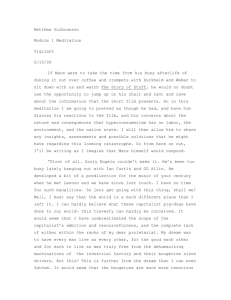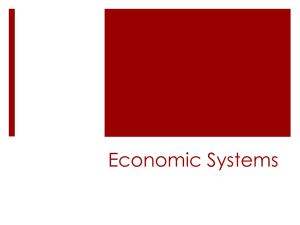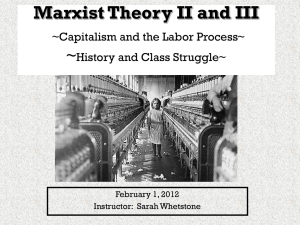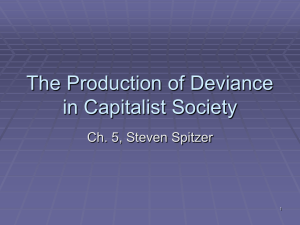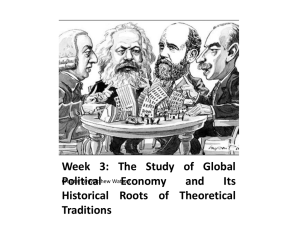E307 5 Karl Marx
advertisement
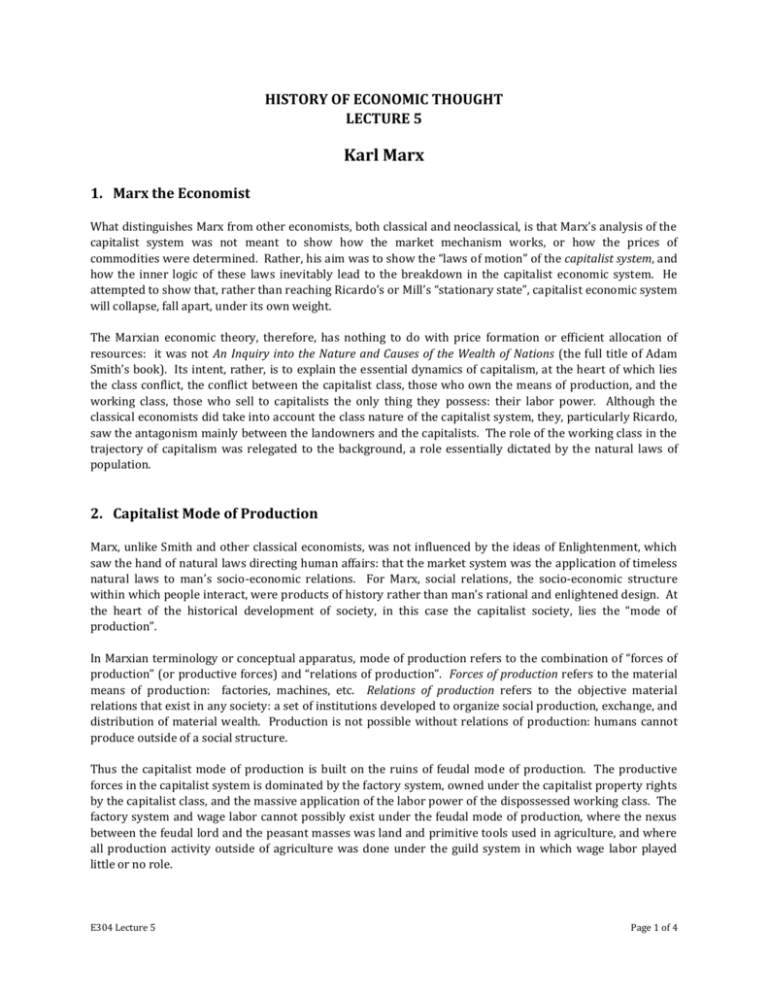
HISTORY OF ECONOMIC THOUGHT LECTURE 5 Karl Marx 1. Marx the Economist What distinguishes Marx from other economists, both classical and neoclassical, is that Marx’s analysis of the capitalist system was not meant to show how the market mechanism works, or how the prices of commodities were determined. Rather, his aim was to show the “laws of motion” of the capitalist system, and how the inner logic of these laws inevitably lead to the breakdown in the capitalist economic system. He attempted to show that, rather than reaching Ricardo’s or Mill’s “stationary state”, capitalist economic system will collapse, fall apart, under its own weight. The Marxian economic theory, therefore, has nothing to do with price formation or efficient allocation of resources: it was not An Inquiry into the Nature and Causes of the Wealth of Nations (the full title of Adam Smith’s book). Its intent, rather, is to explain the essential dynamics of capitalism, at the heart of which lies the class conflict, the conflict between the capitalist class, those who own the means of production, and the working class, those who sell to capitalists the only thing they possess: their labor power. Although the classical economists did take into account the class nature of the capitalist system, they, particularly Ricardo, saw the antagonism mainly between the landowners and the capitalists. The role of the working class in the trajectory of capitalism was relegated to the background, a role essentially dictated by the natural laws of population. 2. Capitalist Mode of Production Marx, unlike Smith and other classical economists, was not influenced by the ideas of Enlightenment, which saw the hand of natural laws directing human affairs: that the market system was the application of timeless natural laws to man’s socio-economic relations. For Marx, social relations, the socio-economic structure within which people interact, were products of history rather than man’s rational and enlightened design. At the heart of the historical development of society, in this case the capitalist society, lies the “mode of production”. In Marxian terminology or conceptual apparatus, mode of production refers to the combination of “forces of production” (or productive forces) and “relations of production”. Forces of production refers to the material means of production: factories, machines, etc. Relations of production refers to the objective material relations that exist in any society: a set of institutions developed to organize social production, exchange, and distribution of material wealth. Production is not possible without relations of production: humans cannot produce outside of a social structure. Thus the capitalist mode of production is built on the ruins of feudal mode of production. The productive forces in the capitalist system is dominated by the factory system, owned under the capitalist property rights by the capitalist class, and the massive application of the labor power of the dispossessed working class. The factory system and wage labor cannot possibly exist under the feudal mode of production, where the nexus between the feudal lord and the peasant masses was land and primitive tools used in agriculture, and where all production activity outside of agriculture was done under the guild system in which wage labor played little or no role. E304 Lecture 5 Page 1 of 4 It was the change in productive forces—new technology, more advanced means of production, higher level of division of labor—and the resulting expansion of trade and urbanization which required a new set of institutions, new relations of production. This is what brought about the demise of feudal mode of production. New technology, the factory system needed a massive human labor to operate or work with the machinery in gigantic plants, such as the textile mills of the 19th century England. This required a new class of dispossessed persons, the working class, who were detached from land or lost their own means of production in the old cottage industry. In the preface to A Contribution to the Critique of Political Economy Marx writes, At a certain stage of their development, the material productive forces of society come in conflict with the existing relations of production, or—what is but a legal expression for the same thing—with the property relations within which they have been at work hitherto. From forms of development of the productive forces these relations turn into their fetters. Then begins an epoch of social revolution....No social order ever perishes before all the productive forces for which there is room in it have developed; and new, higher relations of production never appear before the material conditions of their existence have matured in the womb of the old society itself. Marx attempted to show that similar motive force operates within the capitalist mode of production, where the development of productive forces reach a stage at which they come into an irreconcilable conflict with the capitalist production relations, a conflict which brings about the collapse of that economic system. 3. Surplus Value What distinguishes the economic circulation or transactions in the capitalist system from the economic circulations in the pre-capitalist mode of production? Marx represented this difference in a simple model containing two variables commodity (𝐶) and money (𝑀). Money in the pre-capitalist era was solely a means of exchange. The artisan producer, say the hat maker, takes his handicraft, C, to market and exchanges it for money, M, and, in turn, uses the same money to buy commodities for his own consumption. The simple scheme is then: 𝐶 → 𝑀 → 𝐶. The C at the end of the cycle has the value equivalent to that of the C at the beginning. This simple model of circulation is what Say (of the Say’s Law fame) has in mind. Recall from the last chapter this statement from Say: A product is no sooner created than it, from that instant, affords a market for other products to the full extent of its own value. In Marxian economic theory, this is a truism that does not describe the nature of capitalist transactions. The capitalist’s objective in production is not to produce something in order to exchange for something else to satisfy his needs. The capitalist’s objective in production is solely to make a profit. Thus, a more accurate schematic description of circulation under capitalism is: 𝑀 → 𝐶 → 𝑀′. Here the capitalist start with M, money or investment funds, and exchanges it for C, machinery, labor and raw material, to produce more commodities and then exchange them for more money, 𝑀′. The only reason the capitalist engages in this transaction is that he expects 𝑀′ > 𝑀, that is the difference ∆𝑀 = 𝑀′ − 𝑀 > 0. This is the capitalist’s profit, which Marx calls surplus value, the source of capital accumulation. The pursuit of surplus value, not the satisfaction of the capitalist’s own needs that distinguishes capitalism from the pre-capitalist market exchanges. It is the capitalists insistence on accumulation that contains the seeds of the capitalist system’s demise. E304 Lecture 5 Page 2 of 4 4. Marxian Labor Theory of Value In Marxian frame of analysis, unlike that of Smith and Ricardo, labor theory of value is not intended for explanation of the determination of relative prices, but rather for the identification of the economic system in which labor power becomes a commodity. Capitalism has created a class devoid of any productive property, the working class, who have no alternative but to sell their labor power, their sheer ability to work, as a commodity. This is the main component of the “C” in the capitalist circulation scheme, 𝑀 → 𝐶 → 𝑀′. Marx calls this labor power the abstract labor, a term that is at the core of labor theory of value and surplus value. Only in the capitalist system the abstract labor can be bought and sold like so much corn or cloth. The labor theory of value implies that the value of commodity consists of the abstract labor embodied or materialized in a commodity. In this context, the term abstract labor takes on a specific meaning: it is the socially necessary labor time or the average labor time per unit of output. The concept is similar to what we now know as labor productivity, which is determined by the existing level of technology. Labor productivity measures output per unit of labor (𝑄 ⁄𝐿, or the average product of labor). Socially necessary labor is the inverse of the quotient 𝑄 ⁄𝐿, which is 𝐿⁄𝑄 . This is the socially necessary labor time embodied in a unit of the commodity—labor per unit of output. The value of a product or commodity is therefore measured in terms of the units of socially necessary labor embodied in that commodity. How do we then relate surplus value to labor theory of value? Here Marx defines a unique commodity, namely “labor power”. But, like all other commodities, the value of labor power is also determined by the amount of the socially necessary labor time needed to produce it. Here the argument is similar to that of the classical subsistence wage theory. How much socially necessary labor time is needed to produce the commodity bundle necessary for labor’s subsistence? The average wage the average worker receives is equivalent to the average or abstract labor time to “produce” his labor power, allow him to subsist. Here is now the source of surplus value: In the exchange between the worker and capitalist, the worker receives exactly the value of his labor power, his subsistence wage, the amount of labor that goes into that labor power. If it takes six hours of socially necessary labor, priced at, say, one dollar per hour, to produce the subsistence commodity bundle per worker, then the worker is worth, and receives, six dollars a day. However, the worker’s contract requires him to work, say, 10 hours a day. Then he is creating ten hours of worth of value. The difference between what the capitalist pays the worker, the value of the worker’s labor power, and the value of the commodity the capitalist sells, equivalent of ten hours of labor, Marx calls surplus value: He pays for six hours, but receives for 10 hours: 𝑀 = 6 → 𝐶 → 𝑀′ = 10. 5. The Falling Rate of Profit What allows this unequal exchange between the capitalist and the worker? The answer is the property relations, the relations of production under the capitalist system. Capitalists own the means of production and, thereby, own the jobs. Workers are at the mercy of capitalists; they have no right, and no power, to ask for more than what each worker’s labor power is worth as a commodity. When a worker sells his labor power to the capitalist he does receive the “fair” value for that commodity at the instance the exchange takes place. According the classical theory, which Marx also relied on, capitalist must prepay workers from the circulating capital, also know as wages fund. Thus, workers receive what they are worth before the production process. But in the production process workers generate more than the equivalent value of their spent labor power—they generate surplus value. Production process also involves capital, to be exact, fixed capital, in addition to circulating capital. The latter is what the capitalist prepays the worker, as the value of labor power. Denoting fixed capital as 𝐾 and the 𝐾+𝐿 circulating capital as 𝐿, the amount of fixed and circulating capital embodied per unit of the commodity is . 𝑄 E304 Lecture 5 Page 3 of 4 The larger the share or proportion of 𝐿, the labor power of the living labor, the more profitable production is for the capitalist, because only the labor power of the living labor generates surplus value. Since capitalists are in competition with each other they must expand the scale of production, they must grow. If they don’t, they well be trampled under competitive forces. To expand the scale of output, capitalists have two options. They can hire more workers. But as they compete for the available supply of labor, they will bid up wages. They will have to pay more than the value of labor power. This, clearly, would reduce the amount of surplus value workers generate. On the other hand, they could expand the production scale by substituting more machinery, fixed capital 𝐾, for the circulating capital 𝐿. But this also has negative consequences for the capitalist’s profits. As the share of fixed capital in the numerator of the quotient 𝐾+𝐿 𝑄 rises, the circulating capital 𝐿, the source of profits (surplus value), is squeezed out. The rate of profit thus falls. This quest for expansion and growth on the part of capitalists, and the inevitable squeeze on, and decline of, the rate of profit was, for Marx, the source of economic crisis of capitalism. Recall that Ricardo and Mill also predicted the decline in capitalists profits which provided the trajectory towards the stationary state. For Marx, the ultimate end of this trajectory was not the stationary state, but the total collapse of capitalism as a mode of production, as an episode in mankind’s history. E304 Lecture 5 Page 4 of 4
